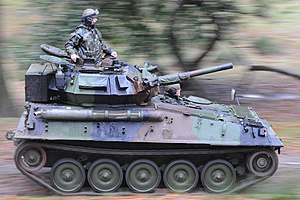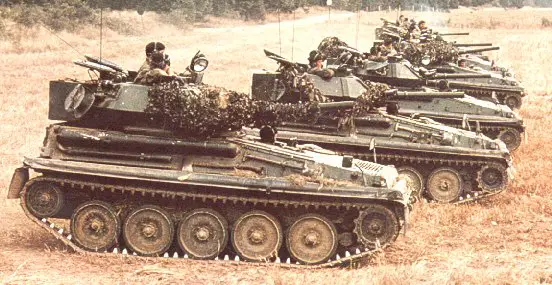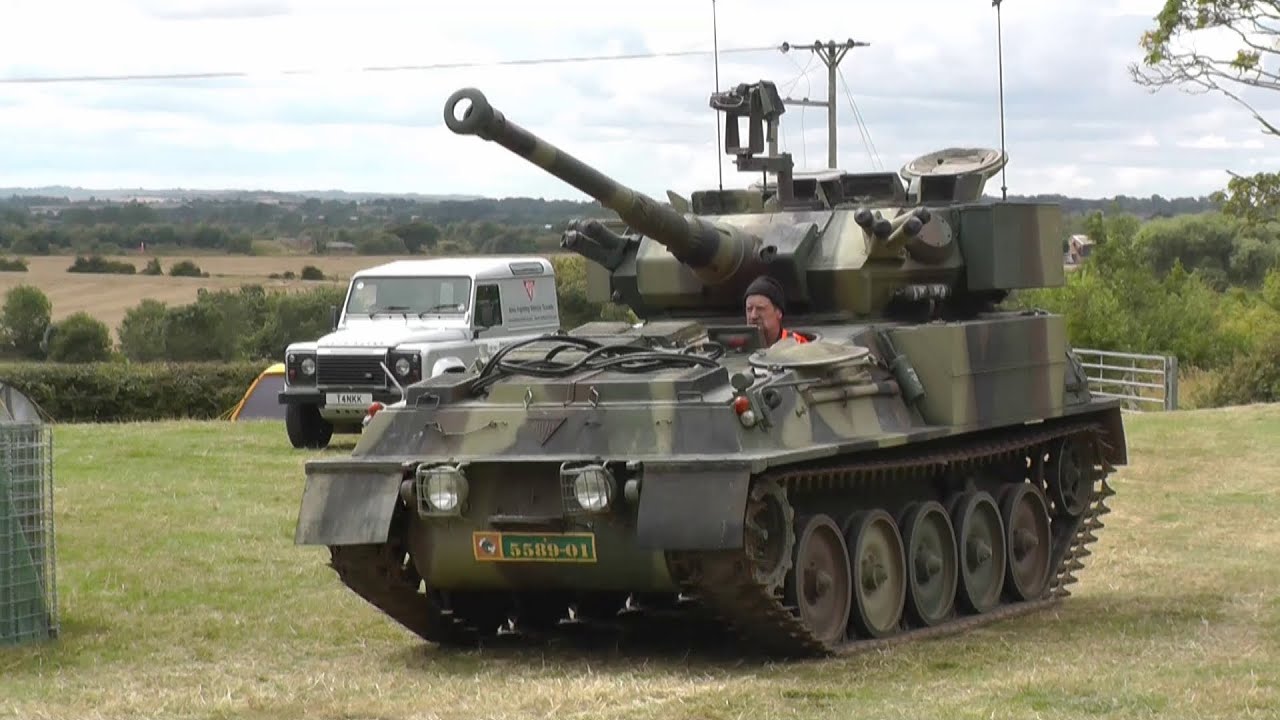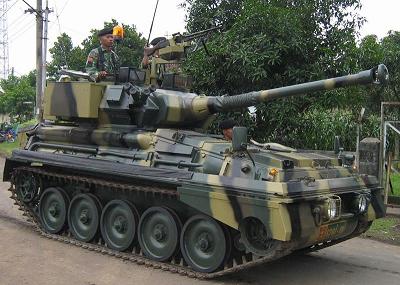

Country of origin
United Kingdom
Entered service1973
Crew3 men
Dimensions and weight
Weight7.93 t
Length4.4 mWidth2.2 mHeight2.1 m
ArmamentMain gun76.2 mm rifled
Machine guns1 x 7.62 mmElevation range- 10 to + 35 degreesTraverse range360 degrees
Ammunition loadMain gun45 roundsMachine guns3 000 rounds
MobilityEnginePerkins dieselEngine power195 hpMaximum road speed87 km/hMaximum amphibious speed6.4 km/hRange640 km
ManeuverabilityGradient60%Side slope30%Vertical step0.5 mTrench2 mFording1 mFording (with preparation)Amphibious


Armament
L23A1 gun
Place of originUnited Kingdom
Service history
In service 1973–present
Production history
Manufacturer Royal Ordnance
Specifications
Length 2.157 m (7 ft 0.9 in)
Calibre 76 mm (3.0 in)Rate of fire 6 rounds per minute
Effective firing range 2,200 m (2,400 yd)

The Scorpion was armed with the low velocity 76 mm L23A1 gun, which could fire high-explosive, HESH, smoke and canister rounds. Stowage was provided for 40 or 42 rounds. A 7.62 mm coaxial machine gun (3,000 rounds carried) was also fitted, as were two multi-barreled smoke grenade dischargers, one on each side of the turret.The main armament has an elevation of 35 degrees and a depression of 10 degrees; the turret has a full 360-degree traverse.
Engine
The original engine was the Jaguar J60 4.2-litre petrol engine, which was replaced by a Cummins or Perkins diesel engine The maximum speed was about 50 miles per hour (80 km/h) and it could accelerate from nought to 30 miles per hour (48 km/h) in 16 seconds. The maximum speed on water (with the flotation screen deployed) was 3.6 mph (5.8 km/h). The Irish engineering company IED replaced the existing Jaguar engine in a successful re-powering process with a Steyr M16 TCA HD engine (6-cylinder, 145 kW), making the Scorpion more powerful and more reliable in critical environments.
Armour
The FV101 was a very light armoured vehicle, weighing in at a mere 8 tonnes. This meant some compromises had to be made on protection. The vehicle had 12.7 mm[12] of aluminium armour all around, giving it protection against small low-velocity shrapnel and standard ball rifle rounds from cartridges such as 7.62×39mm, 5.56×45mm, and 7.62×51mm.
Other systems
The vehicle was fitted with a nuclear, biological, chemical protection system, image intensification sights for gunner and driver and a floatation screen. A commode was located under the commander's seat, an internal water tank and a boiling vessel for cooking and heating water were also provided.
Scorpion 90
The Scorpion 90 or Scorpion 2 was a version armed with the long-barrelled Cockerill Mk3 M-A1 90mm gun designed for the export market.

Service history
The Scorpion was or is used by the armed forces of Belgium, Botswana, Brunei, Chile, Honduras, Iran, Indonesia, Ireland, Jordan, Malaysia, New Zealand, Nigeria, Oman, Philippines, Spain, Tanzania, Thailand, Togo, Venezuela and the United Arab Emirates.[1] Iranian army acquired 250 Scorpions in the late 1970s and a number of them are still in use after being refurbished locally as the Tosan tank. While Canada never operated the Scorpion, its original turret was married with the MOWAG Piranha I chassis to create the AVGP Cougar fire support vehicle, which was used by the Canadian Armed Forces. The Scorpion on occasion deployed to main UK airports as a measure against possible terrorist threats, e.g., Operation Marmion at Heathrow Airport in 1974. Similar operations in 2003 used the then-current Scimitar.

Combat use
Scorpion advancing across the desert during the first Gulf War.
Two troops from B Squadron, Blues and Royals served in the Falklands War. One troop was equipped with four Scorpions, the other with four FV107 Scimitars. These were the only armoured vehicles used in action by the British Army during the conflict.Scorpions also served in the Gulf War. The 1st Queen's Dragoon Guards, a reconnaissance regiment, had 32 and the close reconnaissance troops of the armoured regiments each had eight.They were also used by 1 Squadron RAF Regiment, which was attached to the 1st British Armoured Division.

Foreign users
Some small armies, such as the Botswana Defence Force and the Irish Army, and notably the larger Philippine Army and Nigerian Army continue to use the Scorpion, in some cases up-armed with the 90mm Cockerill.
The Iranian army used its Scorpion tanks in the Iran-Iraq War. It seems they were not very successful and losses and lack of spare parts soon meant all of them were out of service.
